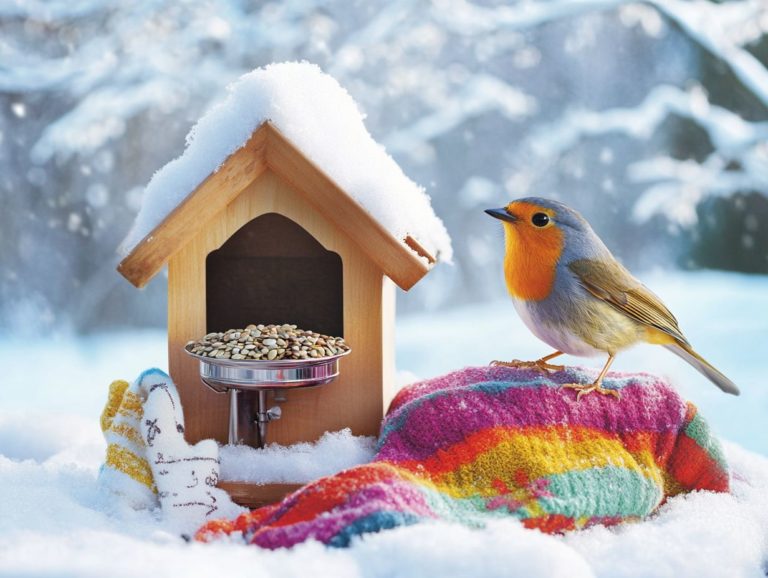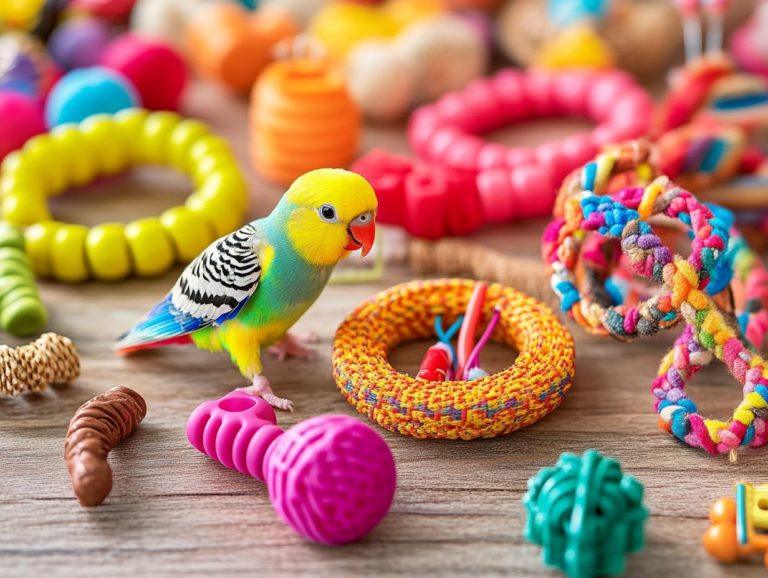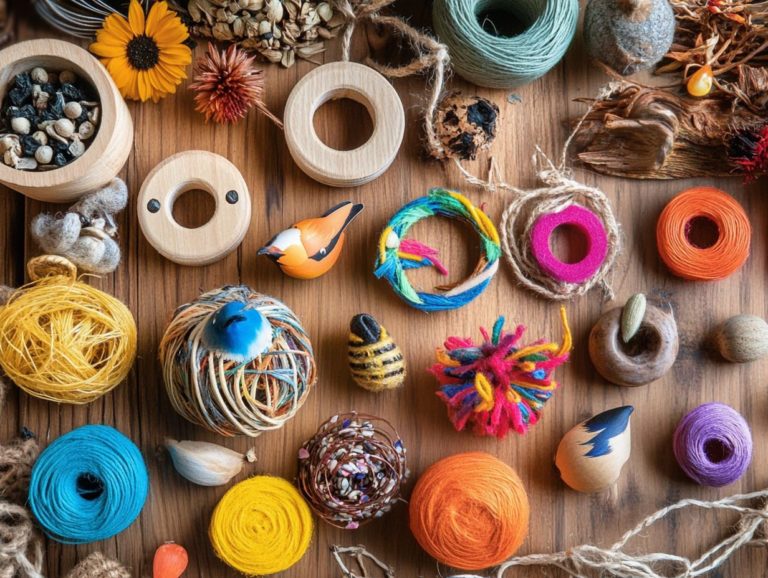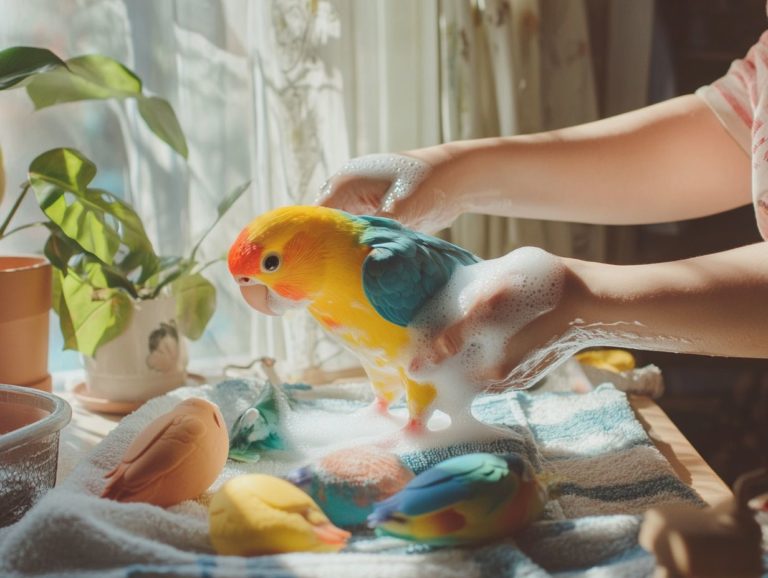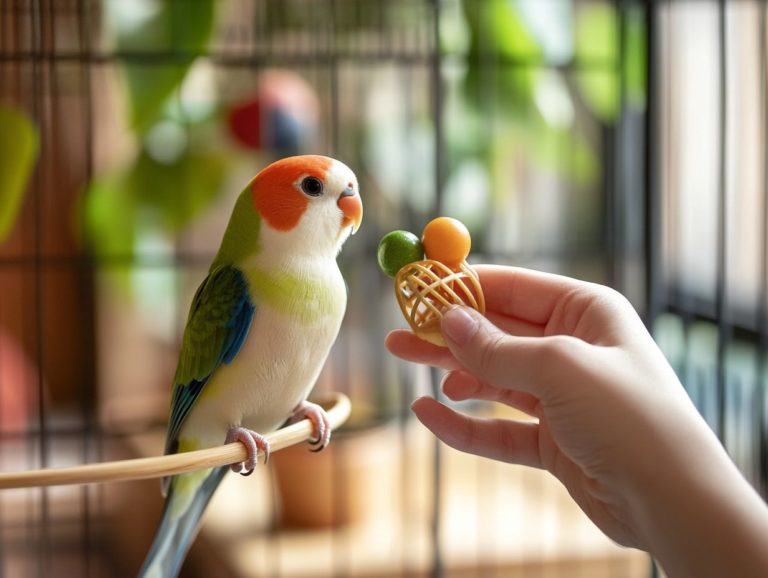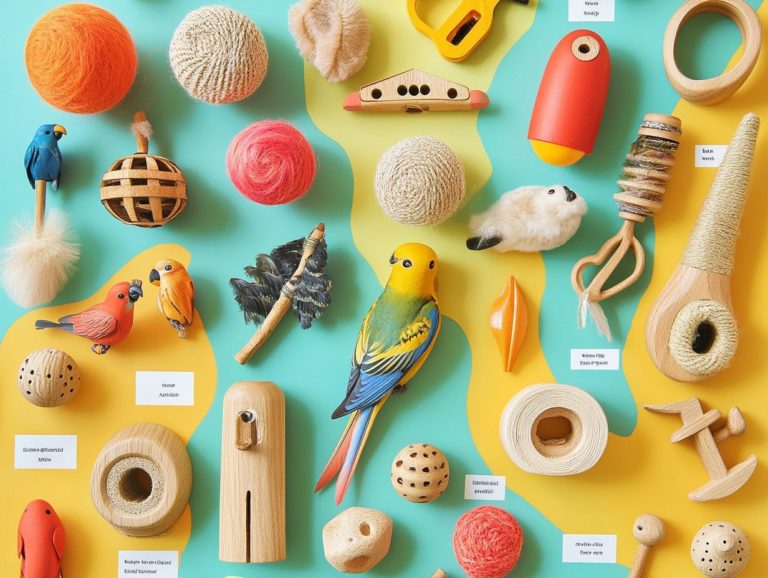How Often to Replace Bird Toys
Birds, much like any cherished pets, thrive on stimulation and engagement. Toys are vital to their happiness and overall well-being.
Understanding how often to replace these toys is crucial for maintaining a safe and enriching environment for your feathered companions. This article explores the various factors that influence toy replacement frequency, considering aspects such as bird species, size, and chewing habits.
You ll also learn to identify clear signs that a toy needs replacing, along with tips for effective cleaning and maintenance. Want your birds to be happy? Keep their toys fresh and fun!
Dive in to ensure your birds are always chirping with joy and enjoying their exercise routine!
Contents
- Key Takeaways:
- Why Toys Matter for Your Feathered Friends!
- Factors that Affect Toy Replacement Frequency
- What Toys are Best for Your Bird’s Size and Species?
- Why Do Birds Love to Chew and How Can You Support This Behavior?
- Signs That It’s Time to Replace Bird Toys
- How to Properly Clean and Maintain Bird Toys
- Alternatives to Traditional Bird Toys
- Frequently Asked Questions
- How often should bird toys be replaced?
- What are the signs that a bird toy needs to be replaced?
- Can I wash and reuse bird toys instead of replacing them?
- Do I need to replace all bird toys at the same time?
- How can I make bird toys last longer?
- Are there any types of bird toys that last longer than others?
Key Takeaways:
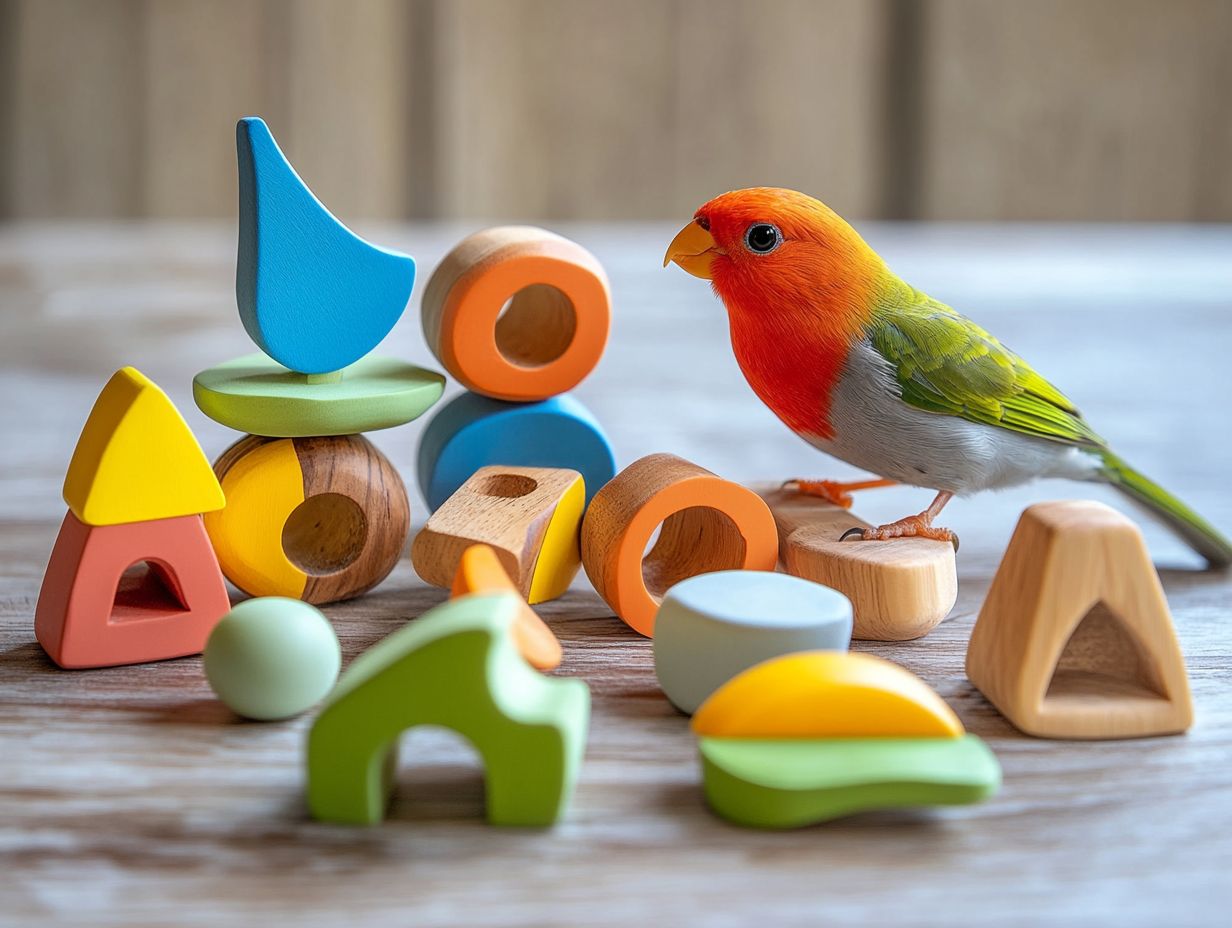
- Regularly replace toys for your bird’s well-being.
- Factors like toy type, bird species, size, and chewing habits affect how often toys should be replaced.
- Watch for signs of wear, like broken parts, to know when to replace your bird’s toys. Proper cleaning can also extend their lifespan.
Why Toys Matter for Your Feathered Friends!
Toys play a pivotal role in the well-being of birds, especially parrots. They provide important mental activity, exercise, and foster a happy environment.
A carefully selected assortment of toys caters to different personality types and activity levels, which is essential in preventing boredom and unusual behaviors like excessive vocalizing or feather plucking.
Rotating a variety of interactive toys crafted from bird-safe materials like wood and seagrass helps enrich their living experience at home, ensuring they feel both comfortable and secure.
Factors that Affect Toy Replacement Frequency
When replacing toys for your feathered companions, consider factors like your bird’s age, personality, and activity level. For example, a curious and energetic parrot may need new toys more frequently than a more laid-back companion.
Keep an eye out for signs of boredom like disinterest or destructive behaviors which can signal it s time for a refreshing replacement.
Types of Toys
Bird toys come in a variety of types, each carefully crafted to stimulate different facets of your bird’s natural behaviors, essential for their overall enrichment. Interactive toys that promote problem-solving, like puzzles or foraging toys, invite your parrots to engage their curiosity.
Chewing toys cater to their instinctual need to gnaw, promoting dental health and preventing destructive behaviors.
Foraging toys replicate the challenges birds face in the wild, encouraging them to hunt for hidden treats and enhancing their natural instincts. This play nurtures a sense of achievement and fulfillment in your feathered companion.
Chewable items made from safe materials satisfy their urge to bite and help keep their beaks trimmed and healthy. By combining various types of bird toys in their environment, you create a vibrant landscape of enrichment, ensuring that every feathered friend enjoys a well-rounded routine of mental stimulation and physical exercise.
Check your bird’s toys today and see what needs replacing!
What Toys are Best for Your Bird’s Size and Species?
The size and type of your bird significantly influence the toy selection process. Each bird species, from the lively GCC Pineapple Conure to the magnificent Scarlet Macaw or the spirited Black-headed Caique, has unique preferences and requirements. Choosing the right toys is vital for your bird’s happiness and well-being!
Smaller birds like the GCC Conure prefer lightweight and easily manipulable toys. Soft ropes and small chewable blocks perfectly suit their energetic and playful nature.
Larger birds like the Scarlet Macaw require more durable toys that can withstand their powerful beaks. Heavy-duty swings or sturdy foraging devices are ideal choices for these majestic creatures.
Behavioral tendencies also play a significant role in toy preferences. The curious nature of a Caique might lead it to gravitate toward interactive toys. Choose options that keep your feathered companion stimulated and effectively ward off boredom.
Why Do Birds Love to Chew and How Can You Support This Behavior?
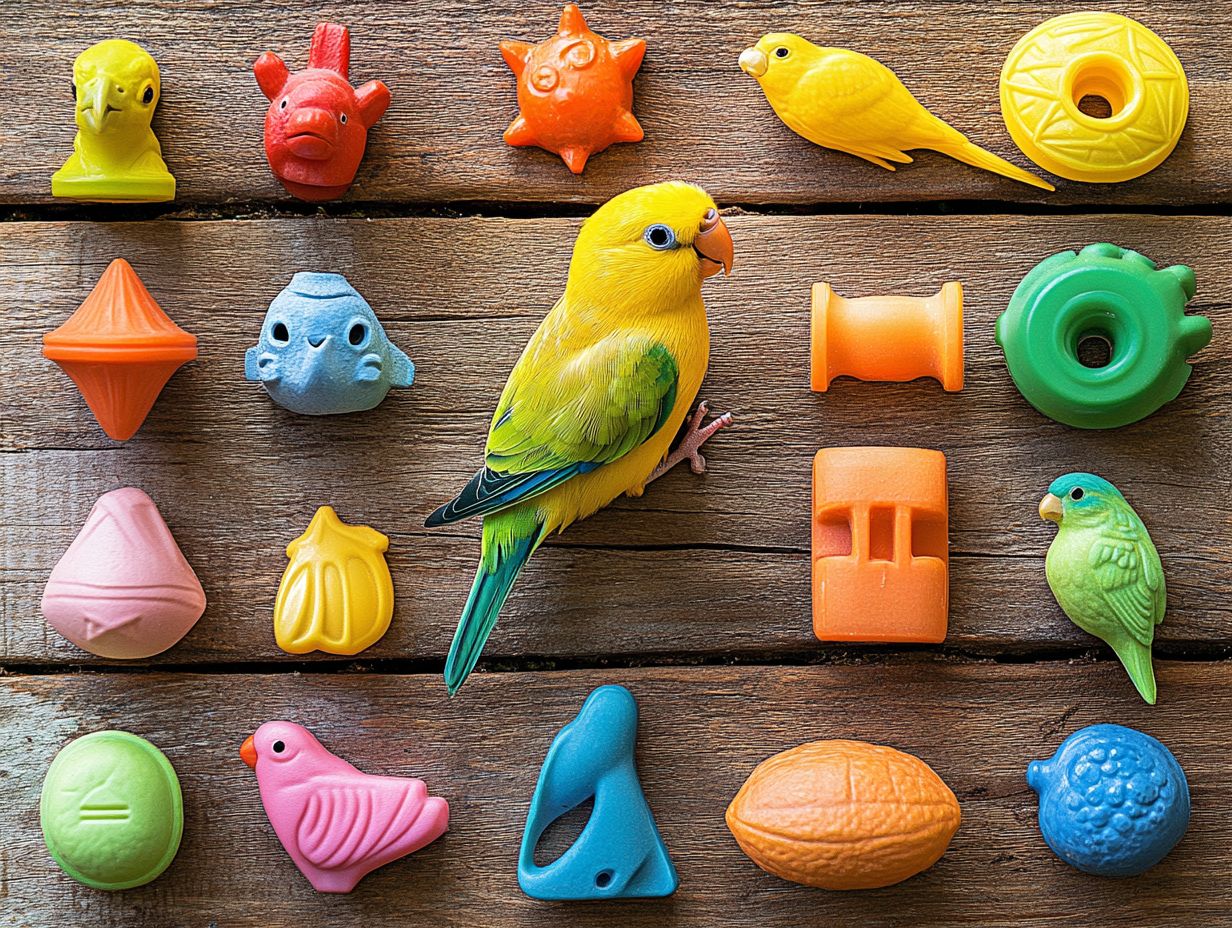
Chewing is a natural and essential behavior for many birds, especially for parrots, as it supports their beak health and provides exercise. Understanding their chewing habits is key when choosing the right toys. By providing toys made from bird-safe materials like untreated wood or seagrass, and offering various textures and shapes, you can cater to their chewing instincts and promote engagement. This not only promotes dental health but also prevents boredom and encourages exploration.
Engaging with diverse materials encourages exploration and mental stimulation. Toys featuring a range of textures from smooth surfaces to rough edges can capture their interest and enhance their foraging instincts, which is their natural behavior of searching for food.
The shape of each toy influences how birds interact with them, opening up avenues for creativity and play.
Safety is paramount when selecting these items. Ensure that each toy is free from harmful chemicals or splinters. By incorporating a mix of engaging forms and safe materials, you ll enrich their experience and nurture their natural behaviors, leading to healthier, happier birds.
Signs That It’s Time to Replace Bird Toys
Recognizing the signs that it’s time to replace bird toys is essential for ensuring a safe and engaging environment for your feathered companions.
When you notice wear and tear like frayed edges or broken parts it s a clear indication that a toy may no longer be safe or stimulating.
By replacing toys promptly, you can prevent potential accidents and keep your birds from succumbing to boredom.
Watch for Signs of Wear!
Wear and tear on bird toys is a natural part of life that can affect both the safety and comfort of your pet, making regular assessments essential. Look for signs of wear like fraying or broken pieces. These can create potential hazards if left unaddressed, so it s crucial to replace any toys that show significant damage.
You might notice fading colors or loose parts, which indicate that the toys are nearing the end of their useful life. Materials that become rough or splintered can injure your bird s delicate beak or toes, while toys that lose their shape may pose a choking risk. Regularly inspect and swap out worn toys to ensure your bird has a safe environment to explore and play in.
Prioritizing the replacement of damaged items allows you to create a secure and nurturing space that fosters happiness and well-being for your beloved pet.
Check your bird s toys today to ensure they re safe and fun!
Broken or Damaged Parts
Broken or damaged parts on bird toys can create significant safety risks. Regularly inspect your pet’s toys for signs of deterioration. If you see any unsafe parts, replace the toy right away. This keeps your bird safe and happy.
Regular maintenance helps prevent accidents. It also creates a fun play environment for your bird. Look for frayed edges, loose pieces, or chips. These can be dangerous if ingested.
Establish a routine inspection schedule aim for a weekly check of the toys. Replace any items at the first sign of wear. By selecting high-quality, bird-safe materials, you minimize risks and provide peace of mind while ensuring your bird remains safe and engaged during playtime.
How to Properly Clean and Maintain Bird Toys
Properly cleaning and maintaining bird toys is crucial for the health and well-being of your feathered companions. This practice eliminates harmful bacteria and extends the lifespan of the toys.
Effective sanitization methods are essential for ensuring that the toys remain safe, engaging, and in peak condition for your bird s enjoyment. Embrace smart storage and rotation practices as well.
Sanitization Methods
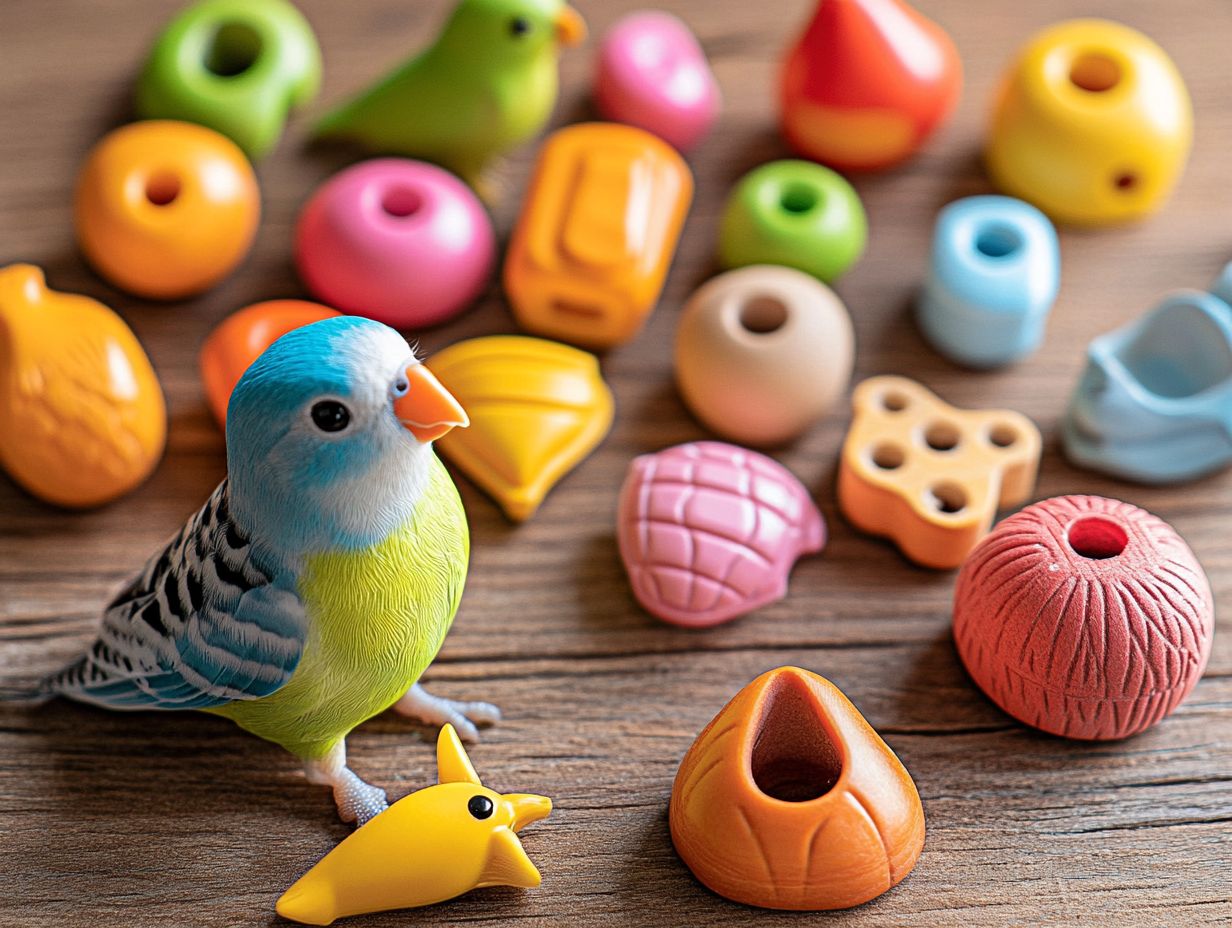
Sanitizing your bird toys can involve a range of techniques, from simple washes to thorough cleaning processes. These methods promote behavioral health and minimize the risk of infection. Use safe cleaning agents and ensure that toys are completely dry before reintroducing them to maintain a pristine environment for your feathered friends.
Regular cleaning reduces harmful bacteria, keeping their spirits high. Consider DIY methods like soaking toys in vinegar or baking soda solutions; they re effective and budget-friendly. If you prefer commercial options, specialized bird toy cleaners are available that are safe for avian use.
Check your bird s toys regularly for any wear and tear! Keeping them safe is the best way to show you care. Prioritize cleanliness to create a healthier space for your birds. A clean environment promotes their well-being!
Storage and Rotation
Effective storage and rotation of bird toys are crucial practices that keep your feathered companions engaged and stave off boredom. By regularly changing access to different toys, you sustain their interest and foster a stimulating environment.
Create a rotation schedule to ensure that toys remain fresh and enticing. Categorize toys by type such as interactive puzzles or chewable items. Introduce new textures or sounds to engage their senses effectively.
Ensure that toys are easily accessible and organized to encourage your birds to explore them frequently. Incorporating seasonal rotations or thematic play can elevate their engagement even further.
A well-managed toy environment alleviates boredom and significantly boosts cognitive skills during playtime.
Alternatives to Traditional Bird Toys
Explore fun alternatives to traditional bird toys! Your feathered friends will love the new experiences. By considering natural and DIY options, you cater to their diverse needs and preferences.
These alternatives ignite curiosity and engagement, prioritizing the safety and well-being of your birds. Ensure a fulfilling environment for them to thrive.
Natural and DIY Options
Natural and DIY bird toys offer a great chance for you to be creative and enriching. You can customize experiences that align perfectly with your birds’ unique preferences.
From safe, foraged materials to homemade puzzles, these toys provide fun play while ensuring safety and engagement.
For example, by using untreated wood, natural fibers like sisal, and the occasional piece of coconut shell, you can create unique toys that spark curiosity in your feathered friends. Transform items like cardboard boxes into interactive hide-and-seek structures or use crumpled paper for some shreddable fun.
Always avoid any toxic substances to keep your birds safe. Supervise playtime to ensure their safety as they explore their new toys. Combine fun with safe materials to enhance your pets’ quality of life and enjoy the joy of making something special for them.
Frequently Asked Questions
How often should bird toys be replaced?
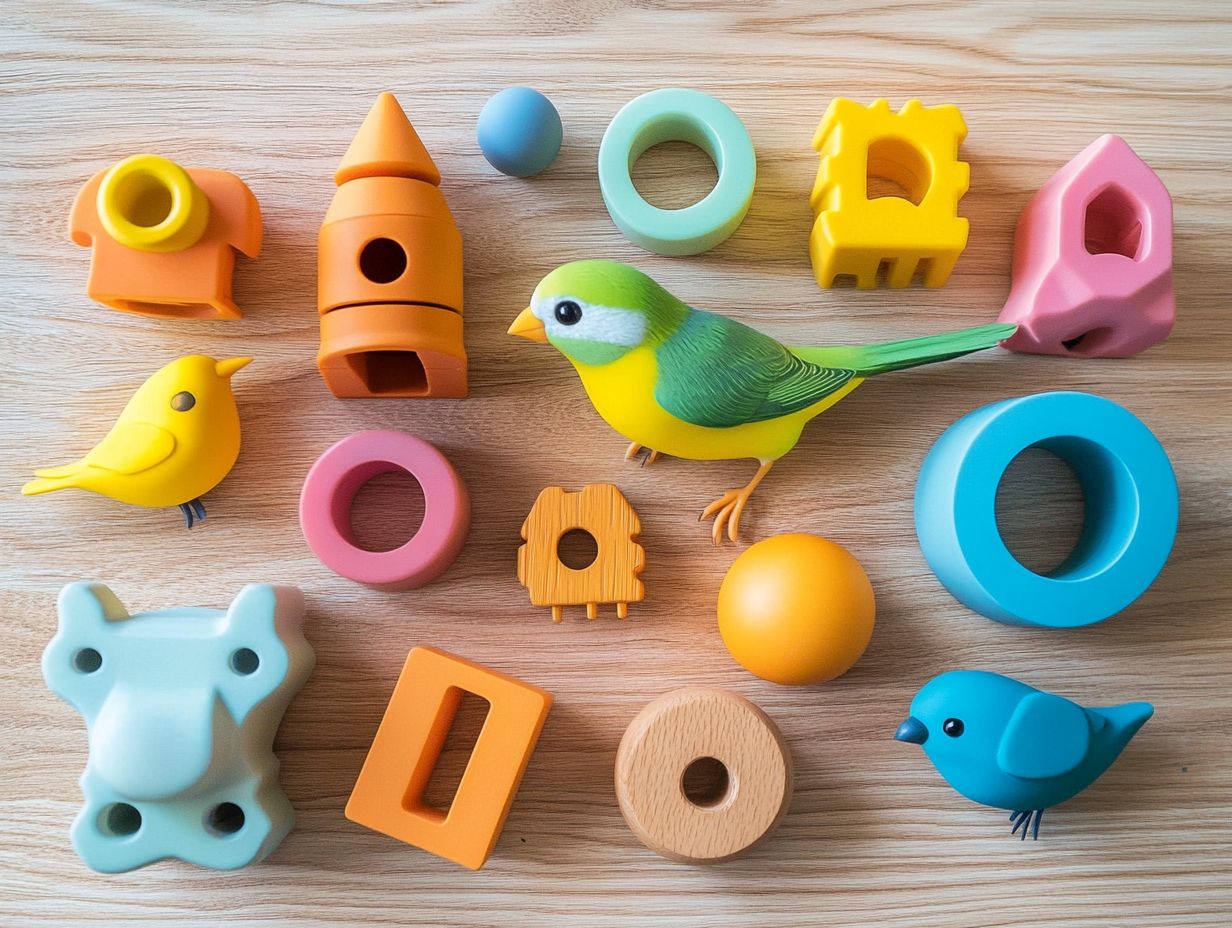
Bird toys should be replaced every 1-2 months, depending on the type and frequency of use. For a more effective approach, consider how to create a toy rotation for your bird, as some toys may need to be replaced more often if they become damaged or dirty.
What are the signs that a bird toy needs to be replaced?
Signs that a bird toy needs replacing include visible wear and tear, broken or missing pieces, and damage like frayed ropes or sharp edges. If the toy is no longer engaging for your bird, it’s time for a replacement.
Can I wash and reuse bird toys instead of replacing them?
Washing and reusing bird toys is not recommended due to potential bacterial buildup and health hazards for your bird. It’s best to replace old toys with new ones for a safe and engaging environment.
Do I need to replace all bird toys at the same time?
No, you don’t need to replace all bird toys simultaneously. Replace them individually as needed based on their condition and your bird’s interest.
How can I make bird toys last longer?
To extend the life of bird toys, rotate them periodically with other toys to keep your bird engaged. Regularly inspect toys for signs of wear and replace them promptly when needed.
Are there any types of bird toys that last longer than others?
Some bird toys, made from durable materials like hard plastic or metal, may last longer. However, always check and replace these toys as they can still get damaged or lose their appeal over time.

